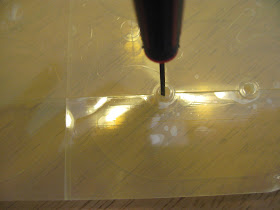But I've found the Z folds aren't very effective for clearing holes smaller than about 1cm, and very small holes simply can't be 'peeled' at all. Small holes have to be cleared by mechanically scraping the waste material out of the holes. In that situation I found it helpful run a peeling cut through the interior of the hole, as shown here.

It worked best to clear holes before peeling the material around the part. The peeling cut through the center of the hole provides an edge that can be scraped without touching or damaging the surrounding part. When I twirled a fine-point jeweler's screwdriver on the peeling cut, it worked its way into the cut and loosened the waste material. (The pictured hole is about 3.5mm across.)

This technique proved doubly-useful with blind holes: Firstly, the twirling screwdriver loosened the waste material without damaging the bottom of the hole. Secondly, the cut provided a visual reminder when there was still waste material in the hole. When the cut line disappeared, the hole was clean.

No comments:
Post a Comment